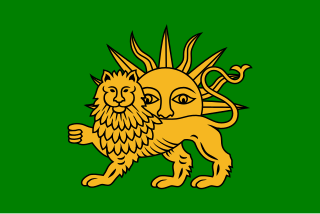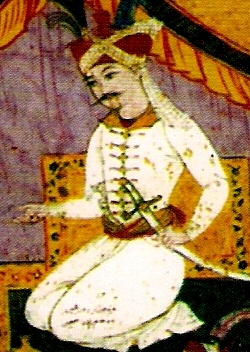Related Research Articles

The Safavid dynasty was one of Iran's most significant ruling dynasties reigning from 1501 to 1736. Their rule is often considered the beginning of modern Iranian history, as well as one of the gunpowder empires. The Safavid Shāh Ismā'īl I established the Twelver denomination of Shīʿa Islam as the official religion of the Persian Empire, marking one of the most important turning points in the history of Islam. The Safavid dynasty had its origin in the Safavid order of Sufism, which was established in the city of Ardabil in the Iranian Azerbaijan region. It was an Iranian dynasty of Kurdish origin, but during their rule they intermarried with Turkoman, Georgian, Circassian, and Pontic Greek dignitaries, nevertheless, for practical purposes, they were Turkish-speaking and Turkified. From their base in Ardabil, the Safavids established control over parts of Greater Iran and reasserted the Iranian identity of the region, thus becoming the first native dynasty since the Sasanian Empire to establish a national state officially known as Iran.

Tahmasp I was the second shah of Safavid Iran from 1524 until his death in 1576. He was the eldest son of Shah Ismail I and his principal consort, Tajlu Khanum.

Ismail I was the founder and first shah of Safavid Iran, ruling from 1501 until his death in 1524. His reign is often considered the beginning of modern Iranian history, as well as one of the gunpowder empires. The rule of Ismail I is one of the most vital in the history of Iran. Before his accession in 1501, Iran, since its Islamic conquest eight-and-a-half centuries earlier, had not existed as a unified country under native Iranian rule. Although many Iranian dynasties rose to power amidst this whole period, it was only under the Buyids that a vast part of Iran properly returned to Iranian rule (945–1055).

Ismail II was the third shah of Safavid Iran from 1576 to 1577. He was the second son of Tahmasp I with his principal consort, Sultanum Begum. On the orders of Tahmasp, Ismail spent twenty years imprisoned in Qahqaheh Castle; whether for his recurrent conflicts with the realm's influential vassals, or for his growing popularity with the Qizilbash tribes, resulting in Tahmasp becoming wary of his son's influence.

Mohammad Khodabanda, was the fourth Safavid shah of Iran from 1578 until his overthrow in 1587 by his son Abbas I. Khodabanda had succeeded his brother, Ismail II. Khodabanda was the son of Shah Tahmasp I by a Turcoman mother, Sultanum Begum Mawsillu, and grandson of Ismail I, founder of the Safavid dynasty.
Khayr al-Nisa Begum was an Iranian Mazandarani princess from the Marashi dynasty, who was the wife of the Safavid shah (king) Mohammad Khodabanda and mother of Abbas I. During the early part of her husband's reign she was a powerful political figure in her own right and governed Iran de facto between February 1578 and July 1579. She gained power with the assassination of Pari Khan Khanum.

Ibrahim Mirza, Solṭān Ebrāhīm Mīrzā, in full Abu'l Fat'h Sultan Ibrahim Mirza was a Persian prince of the Safavid dynasty, who was a favourite of his uncle and father-in-law Shah Tahmasp I, but who was executed by Tahmasp's successor, the Shah Ismail II. Ibrahim is now mainly remembered as a patron of the arts, especially the Persian miniature. Although most of his library and art collection was apparently destroyed by his wife after his murder, surviving works commissioned by him include the manuscript of the Haft Awrang of the poet Jami which is now in the Freer Gallery of Art in Washington D.C.
Abd al-Baqi Yazdi, was a Persian nobleman, who was the third person to serve as the vakil (vicegerent) of the Safavid Empire.

Pari Khan Khanum was a Safavid princess, daughter of the second Safavid Shah, Tahmasp I and his Circassian consort, Sultan-Agha Khanum. From an early age, she was well-loved by her father and was allowed to partake in the court activities, gradually becoming an influential figure who attracted the attentions of the prominent leaders of the militant Qizilbash tribes.

Haydar Mirza Safavi was a Safavid prince who declared himself as the king (shah) of Iran on 15 May 1576, the day after his father Tahmasp I had died. He was, however, killed that same day by the Qizilbash tribes that favoured his brother Ismail Mirza Safavi as the successor of their father. His mother was Sultanzadeh Khanum, a Georgian lady.
Shamkhal Sultan, was an important Kumyk noble of the second half of the 16th century in the Safavid Empire.

Sam Mirza was a Safavid prince and poet in 16th-century Iran, who wrote the Tohfa-ye Sami, a collection of biographies of contemporary Persian poets. He was the third son of Shah Ismail I, the founder of the Safavid dynasty.

Abu'l Ghazi Sultan Alqas Mirza, better known as Alqas Mirza, was a Safavid prince and the second surviving son of king (shah) Ismail I. In early 1546, with Ottoman help, he staged a revolt against his brother Tahmasp I, who was king at the time.

Sultan-Agha Khanum also in Western sources Corasi was a Safavid queen consort of Kumyk origin, as the second wife of Safavid king Tahmasp I.
Suleiman Mirza was a Safavid prince. The son of king Tahmasp I by his Kumyk wife Sultan-Agha Khanum, he functioned several years as an official, serving as the governor (hakem) of Shiraz and Mashhad. His full sister was Pari Khan Khanum, and his Kumyk uncle Shamkhal Sultan – both extremely pivotal figures in Safavid affairs during the latter half of the 16th century.
Tajlu Khanum or Tajli Begum, also known by her title of Shah-Begi Khanum, was a Turkoman princess from the Mawsillu tribe and mother of Tahmasp I.

Mirza Salman Jaberi Isfahani was a prominent Persian statesman in Safavid Iran, who served as the grand vizier of Ismail II and Mohammad Khodabanda.

Abdollah Khan Ustajlu was a high-ranking Iranian dignitary of Turkoman origin, who served during the reign of king (shah) Tahmasp I (1524-1576). He successively held the posts of amir al-omarāʾ (commander-in-chief) and divanbegi, before becoming the governor of Shirvan from 1549 until 1565 or 1566.
Bahram Mirza Safavi was a Safavid prince, governor and military commander in 16th-century Iran. He was the youngest son of Shah Ismail I, the founder of the Safavid dynasty.
Soltan Hosayn Mirza Safavi was a prince of the Safavid dynasty of Iran who ruled as the governor of Kandahar from 1558 until his death in 1577. He was a son of Bahram Mirza and a grandson of Ismail I. His descendants formed a cadet branch of the Safavid dynasty in the Mughal India that survived there for two centuries and became one of the most prominent families in the Mughal court.
References
- ↑ Soucek 1988, pp. 523–524.
- ↑ Parsadust 2009.
- ↑ Gholsorkhi 1995, p. 146.